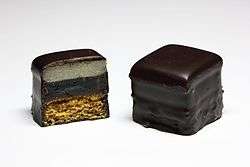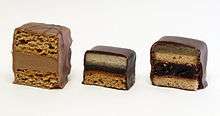Dominostein
A Dominostein (plural Dominosteine, literal translation domino tile) is a sweet primarily sold during Christmas season in Germany and Austria.
 Dominostein, fine bitter chocolate coating | |
| Place of origin | Germany |
|---|---|
| Created by | Herbert Wendler |
| Main ingredients | Lebkuchen, sour cherry or apricot jelly, marzipan or persipan, milk or dark chocolate |

Three varieties of Dominostein
Dominosteine consist of several layers, covered with a thin icing of (typically) dark chocolate. The base consists of Lebkuchen. Further layers contain jelly (e.g. from sour cherries or apricots) and either marzipan or persipan.[1]
The Dominostein was invented in 1936 by Herbert Wendler (1912–1998) in Dresden. The layered praline was targeted for a broader audience because of a lower price than the other products of Wendler's praline product line. During the scarcity of food during World War II the Dominostein gained popularity as a replacement praline.[2][3]
See also
- List of German desserts

References
- "BMEL - Lebensmittel-Kennzeichnung - Leitsätze für Feine Backwaren" [Guidelines for fine pastries]. www.bmel.de (in German). Retrieved 2015-12-25.
- "Dresdner Dominosteine". www.landwirtschaft.sachsen.de (in German). Archived from the original on 2015-12-26. Retrieved 2015-12-25.
- "Dominosteine - Layered Christmas Cookie Recipe from Germany". About.com Food. Retrieved 2015-12-25.
This article is issued from Wikipedia. The text is licensed under Creative Commons - Attribution - Sharealike. Additional terms may apply for the media files.